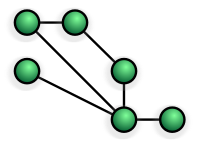
Photo from wikipedia
Our increasing dependence on infrastructure networks leads to growing concerns over the protection of these networks. Many methods have been proposed to select protective strategies by combining complex network theory… Click to show full abstract
Our increasing dependence on infrastructure networks leads to growing concerns over the protection of these networks. Many methods have been proposed to select protective strategies by combining complex network theory and game theory. However, the misleading effect of hidden links is not considered in previous methods. This work creates an information gap between attackers and defenders by partly hiding network links to mislead the attacker in the game. We first introduce the rule of link hiding that depends on the nodes' property, where the number of hidden links has a maximum value. Additionally, based on the Stackelberg game model, we establish an attack-defense game model with link hiding strategies considering node property and cost constraints. Finally, we conduct experiments in a scale-free network and an existing power grid. The experimental results show that the defender tends to combine first-mover advantage and link hiding to get a better payoff under more different costs of the nodes. Hiding half of the links in the existing power grid can effectively reduce network damage by about 22.8% on average, with the two sides investing the same resources. The effect of link hiding could be more obvious when the attacker owns more resources than the defender. When an attacker employs the high-degree attacking strategy, the proposed link hiding method can help the defender reduce the damage to the network by 12.2% compared to the link reconnecting method.
Journal Title: Chaos
Year Published: 2022
Link to full text (if available)
Share on Social Media: Sign Up to like & get
recommendations!